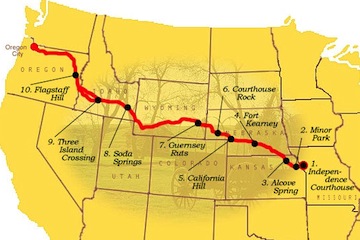The Oregon Trail and its Migration
One of the great migrations in the history of the United States was the rush of settlers to Oregon that started in the 1840s. Several thousand people traveled overland by covered wagon on the 2,000 mile journey, risking everything they had in the venture. Those who made it to Oregon established the foundation of the current state. They also found the personal prosperity in many cases that had escaped them in the east.
Why did so many people brave such a long journey past much other land where people now live and did live at the time? The advantages of the Oregon Territory were legion. It was populated by very few people. It had reliable rainfall, copious timber, and fertile soil. Its inhabitants didn't suffer from malaria and other endemic diseases that still killed many in the 19th century. Last but not least, the land was almost free. Oregon's Provisional Government would award up to 640 acres of land to a married couple (320 acres to a single man) who settled and improved it. This was legitimatized by the U.S. Congress in 1850 with the Donation Land Claim Act. Many new settlers flocked to the Willamette Valley region of the state, where the land provided bountiful produce to any competent farmer. Allotments were reduced in the 1850s and later, so the first settlers who braved the Oregon Trail benefited disproportionately from their enterprising natures.
Oregon was a source of social mobility for whites from the eastern United States. Much of the prime farmland in the eastern states had long since been claimed by the 1840s. Other land was available in lots of 160 acres if someone had been "squatting" on it for some time and established themselves. In other places, land speculators had obtained huge tracts which traded at market price. Oregon did its utmost to discourage such speculation and start its society on a more egalitarian basis. Egalitarian, that is, if one does not account for the Indian tribes that were pushed to marginal land, and even desert. Like other parts of the west, Indians were fought with and sent to the worst tracts of land if they survived. Slavery was prohibited, but free blacks were barred from the new territory. Few would have had any means to get there in the first place.
Wagons were the only practical means of travel. Western geography played a decisive role. The Oregon Trail ran parallel to the Platte River in what is now Nebraska -- a river that was shallow and impassable to even the smallest of boats. The other river that might have been used for water transport, the Missouri, ran much too far north and ended in the midst of impenetrable mountains. A wagon, on the other hand, could pass through the easiest part of the Rocky Mountains -- a relatively flat basin called South Pass in what is now Wyoming. In the west, travel by land was again much more practical than braving the rapids of the Snake or Colombia River via boat. Simply put, there was no artery in the west, such as the Mississippi River in the east, that facilitated internal transport and migration on a large scale. Since there were no towns on the way, migrants had to load their wagons with several hundred pounds of supplies.
One of the great books to come out of the era was The Oregon Trail, by Francis Parkman of New England. Parkman traveled on the first third of the trail, and his accounts added some publicity and Romantic glamour to the great migration westward. Reality was less kind. One in ten migrants died en route; many from diseases such as cholera. If the United States was a land of opportunity, that opportunity did not come easily. These settlers were not fleeing political persecution or the fear of death, like many refugees today with similar casualty rates. They were simply taking a proactive step towards a better life. Is it possible for someone in our modern times to imagine such risk and hardship?
When settlers arrived in Oregon, they created a culture at odds with the popular image of the Wild West. Most arrived there in families. They mostly had no time or interest for the disreputable pursuits that plagued California with its gold miners. The allotment of double the land to a married family ensured a measure of social stability. Oregon became a state on February 14, 1859, with a population of around 60,000 people.
